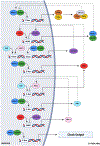Clockwork conditioning: Aligning the skeletal muscle clock with time-of-day exercise for cardiometabolic health
- PMID: 39615287
- PMCID: PMC11780665
- DOI: 10.1016/j.yjmcc.2024.11.011
Clockwork conditioning: Aligning the skeletal muscle clock with time-of-day exercise for cardiometabolic health
Abstract
Circadian rhythms have evolved to synchronize gene expression, physiology, and behavior with time-of-day changes in the external environment. In every mammalian cell exists a core clock mechanism that consists of a transcriptional-translational feedback loop that drives rhythmic gene expression. Circadian disruption, as observed in shift workers and genetic mouse models, contributes to the onset and progression of cardiometabolic disorders. The central clock, located in the hypothalamus, is uniquely sensitive to external light cues, while the peripheral clocks are responsive to non-photic stimuli such as feeding and activity in addition to signals from the central clock. Recent research has illustrated the sensitivity of the skeletal muscle circadian clock to exercise timing, offering a promising avenue for therapeutic intervention in cardiometabolic health. Here we provide an in-depth examination of the molecular mechanisms underlying skeletal muscle clock function and its impact on cardiometabolic pathways, including glucose and lipid metabolism, as well as inflammation. To highlight the role of exercise as a time-cue for the skeletal muscle clock, we discuss evidence of exercise-induced shifts in the skeletal muscle clock and the differential response to exercise performed at different times of the day. Furthermore, we present data in support of time-of-day exercise as a potential therapeutic strategy for mitigating cardiometabolic disease burden. By exploring the relationship between the skeletal muscle clock, exercise timing, and cardiometabolic health, we identify new areas for future research and offer valuable insights into novel therapeutic approaches aimed at improving cardiometabolic disease outcomes.
Keywords: Cardiometabolic disease; Circadian rhythm; Exercise; Muscle clock; Skeletal muscle.
Copyright © 2024 The Authors. Published by Elsevier Ltd.. All rights reserved.
Figures



References
Publication types
MeSH terms
Grants and funding
LinkOut - more resources
Full Text Sources
Medical

